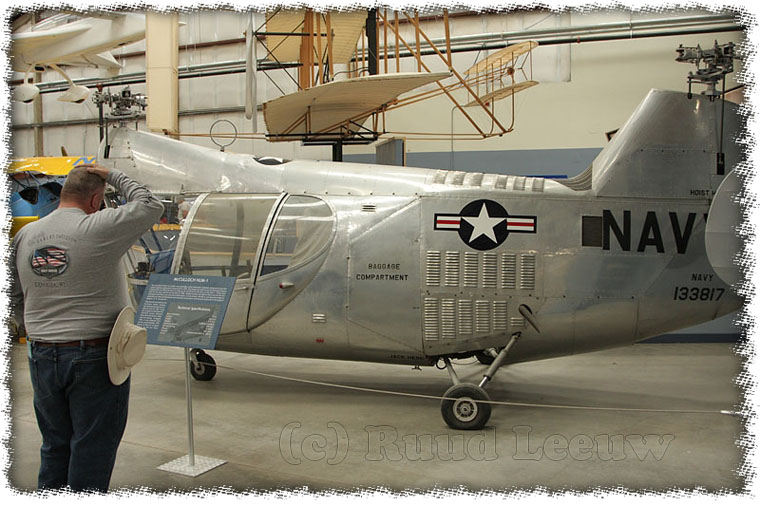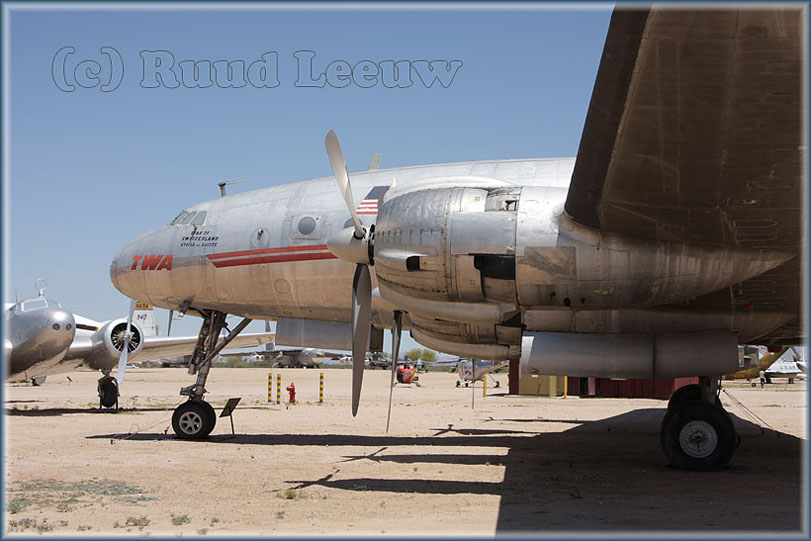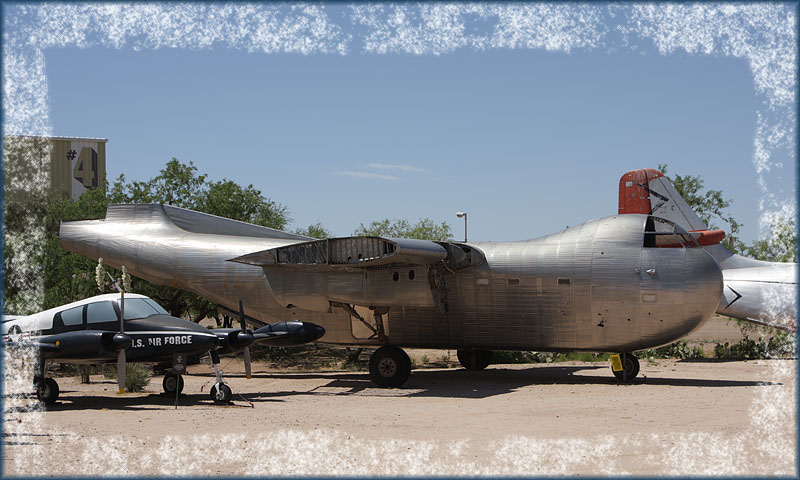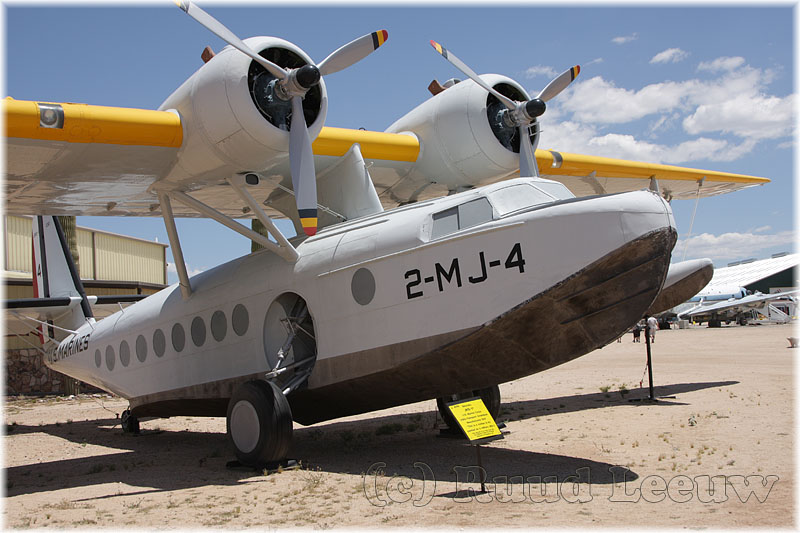
 Photos © Ruud Leeuw
Photos © Ruud Leeuw

 Photos © Ruud Leeuw
Photos © Ruud Leeuw
 Welcome to the Pima Air & Space Museum ! |
 Pima Air & Space Museum is a large aviation museum with a huge selection. Since I was on my own I could continue to photograph without much of a break, except for stopping to have a drink (it was hot!) and even at this pace it took me over 03:30 hours to get it all on camera... Date of visit was 17May08. Things had changed since my first visit here in 1980! |
|
The sign in the museum included the following information: |
 Now you can see him think: "What on earth is this..?" And indeed the museum features some amazing types of aircraft ! |
 It is humongous... No other word for it. This is a 1940-vintage seaplane: the Martin PBM-5A Mariner. The first production Mariners were delivered in 1940 after test flights in 1939. Early model flying boats had retractable wingfloats and Wright Cyclone radial engines, while later (-5A) amphibians had tricycle landinggear, fixed wing floats and Pratt & Witney radials. PBM-5A 122071 here on display was the 5th of 36 -5A's built, delivered to the US Navy on 06May48. it was retired from service in 1956 and sold to Frontier Airways. Last flight of 122071 was on 17Jul71. |
 Design of the Douglas B-18 Bolo was based on the Douglas DC-2! It used similar wings, tail and engines. The Bolo entered production in 1936 and by 1940 most of the bomber squadrons in the US Air Corps were equipped with B-18s. When the US entered WW2 the B-18 was obsolete and was being replaced by the B-17. But 122 B-18A's were modified with a nose-mounted radar and magnetic anomaly detectors for locating submarines. These modified B-18A's were designated B-18B's of which one is here on display. |
|
Ralph Pettersen has more on his website www.conniesurvivors.com |
|
1.584 AT-11 Kansan's were built during 1941 - 1944. |
 The Cessna AT-17 Bobcat was a twin-engined advanced trainer aircraft designed and made in the United States, and used during World War II to bridge the gap between single-engine trainers and twin-engine combat aircraft. The AT-17 was powered by two Jacobs R-755-9 radial piston engines. The commercial version was the Model T-50, from which the AT-17 was developed. [More: Wikipedia] On this display here is a JRC-1, the Navy light transport version of the UC-78, with two Jacobs R-775-9 engines; 67 were delivered. |
 The Convair B-36 (nicknamed Peacemaker was a strategic bomber built by Convair and operated solely by the United States Air Force (USAF). The B-36 was the largest mass-produced piston engined aircraft ever made and the biggest wingspan combat aircraft ever built, although there have been larger military transports. With a range of over 6,000 miles and a maximum payload of at least 72,000 lbs, the B-36 was the first operational bomber with an intercontinental range, setting the standard for subsequent USAF long range bombers, such as the B-52 Stratofortress, B-1 Lancer, and B-2 Spirit. [Source: Wikipedia] Work on its restoration continues. A lot has been done since it arrived here in Oct.2005; during March 2008 the two large sections (forward plus wings against aft) of the fuselage became bolted together. Restoring these aircraft is a monumental task and one can only admire those who tackle these challenges so future generations can enjoy the fruits of their labor. |
| Earles L. McCaul wrote me in aug.2015 with the following update: "As for those PBY Catalina 'parts', current Pima Aerospace inventory lists these four airframe in different derelict states: 1) N10609 PBY-5A 2) N322PA PBY-5A (red paint scheme), original USN BuNo. 02963. 3) N68756 PBY-5A (silver paint scheme), on wheels, original USN BuNo 46590; Canadian A23-387 markings. 4) Unidentified Canso A." EMAIL (pls state url of this page to make subject clear). UPDATE 2018: 'PBY-5As N68756 and N10609 have both been acquired by MotoArt, who specialise in producing high quality artefacts from vintage aircraft. N68756 has already been moved to California (Mojave) and N10609 will follow in due course. The Summer 2018 edition of The Catalina News magazine has a full article on MotoArt's Catalina activity.' www.catalina.org.uk/2018/05/-News, june2018. They can both be considered scrapped! End of story. |
 The Curtiss-Wright C-46 Commando was an American transport aircraft originally designed for commercial use although it was primarily used during World War II by the United States Army Air Forces. Also known to the men who flew them as "The Whale" or even more irreverently as the "Curtiss Calamity".. Tthe C-46 served a similar role as its counterpart, the Douglas C-47 Skytrain, but was not quite as famous or as extensively produced. Postwar, C-46s were briefly used in their original role as passenger airliners, but the glut of surplus C-47s dominated the marketplace with the C-46 soon relegated to a secondary status. However, the C-46 was adopted as a rugged cargo aircraft for northern and remote locations with its service life extended into the 21st Century. [Source: Wikipedia] Note the engine has been named 'Groan'... |
 N90831 (c/n 1970), restored as TWA's 'Star of Switzerland', is the oldest surviving Connie, the sole surviving C-69... One can find its entire history described, plus a photo carrying Lake Havasu City titles, on my Bill Hill Gallery Ralph Pettersen has the true story...: www.conniesurvivors.com |
 Avro Shackleton WL790 Avro Shackleton WL790
For a while there were rumours of WL790 returning to the UK, but it would have been grounded due to regulations, its C of A has expired. WL790 did the air shows in the USA during 2007 and it seems that this remarkable aircraft has found a last resting place here. |
 Now this is a remarkable aircraft: The Budd C-93 Conestoga. It was the first aircraft of original design to be fabricated entirely of shotwelded stainless steel ((a shortage of light alloys was expected). It was designed to meet a U.S. Navy specification for a twin-engined cargo carrier and troop transport. The Army version was known as the C-93, but the initial order was cancelled due to delays caused by manufacturing problems. The Navy version was designated the RB-1, but only 25 of the initial 200 ordered were delivered before cancellation of that order. There never was an aluminium shortage. It saw limited use, after its military career, with cicilian operators. Flying Tigers Cargo operated a few and one was flown by Tucker Automobile Corporation. It had the same engines as the DC-3 (1200hp P&W R-1830-92 'Twin Wasp') and was underpowered due to its own weight. |
 Another remarkable aircraft: Northrop YC-125 Raider.
Another remarkable aircraft: Northrop YC-125 Raider.Northrop's first post-war civil design was a three-engined STOL passenger and cargo transport named the Northrop N-23 Pioneer. The Pioneer could carry 36 passengers or five tons of cargo and first flew on 21 December 1946. The aircraft had a good performance, but there was little interest due to the availability of cheap war surplus aircraft. The Pioneer was lost in a fatal crash in 1947. In 1948 the United States Air Force expressed interest in an aircraft of the same configuration and placed an order with Northrop for 23 aircraft, 13 troop transports designated the C-125A Raider and 10 for Arctic rescue work designated the C-125B. With the company designation N-32 Raider the first aircraft flew on 1 August 1949. [Source: Wikipedia] |
 N462M is a Martin 404 (also written as 4-0-4), c/n 14153. When production of the earlier Martin 2-0-2 was stopped due to problems with wing structural failure the company decided to re-wing an improved version (which had already flown as the Martin 3-0-3). The new aircraft was the Martin 4-0-4, it had structural changes to the wings, pressurization and lengthened slightly to take 40 passengers. N462M was rescued from longtime storage at Sheridan,WY. It had been converted to sprayer to fight insects but was never used as such. It was flown south in Sep.2001 but not without difficulties. It declared an emergency and landed at Winslow,AZ after an engine failed (check out the cylinder sticking out of the no.2 engine). It was finally delivered to the Pima Air Museum on 12Oct01. |
 This Lockheed PV-2 (L-15) Harpoon Bu.37257 (civilian registered N7255C, c/n 15-1223) was restored using the rear fuselage of c/n 15-1156 Bu.37190/N6856C. |
 This Douglas C-124C Globemaster II (52-1004) fits the 'remarkable' catagory quite well, dont you think? |
|
In the catagory "Look what they've done to my plane, Ma..!" I would include this militiary version of the Queen of the Skies: the Lockheed EC-121T 'Warning Star'. It served the US Air Force Reserve (AFRES) last. Note the bulbous extensions on top and below the fuselage, for surveillance equipment. The Lockheed Warning Star began development as the US Navy PO-1W, an early model Constellation Airliner modified to carry experimental electronic surveillance equipment. After the PO-1W proved the concept of airborne early warning in large NATO exercises, the US Navy and Air Force ordered large numbers of a developed variant based on the Lockheed Model 1049 Super Constellation. These aircraft entered service as the Navy WV-2, with 244 ordered, and the Air Force EC-121, 82 ordered of which 72 were from US Navy orders. The Warning Star entered service in 1955, with the final variants being retired from the US Air Force Reserve in 1978. USAF EC-121s were deployed to Vietnam in 1965 to provide coordination, early warning and communications relay. [More...] |
 A civilian Sikorsky S-43 has been decorated here as a JRS-1, a military variant. The Sikorsky S-43 was an 18-place twin engine amphibious aircraft, manufactured in the USA during the 1930s by the American firm Sikorsky Aircraft. It was known as the "Baby Clipper" (Army OA-8, USN JRS-1) in airline service. It was used primarily by Pan American World Airways for flights to Cuba. [More: Wikipedia] The Sikorsky S-43 also saw service with Pan Am in Alaska, see my webpage Aviation History from Phil Smith |
|
Only 38 Dragons were built and none of them ever entered combat. By mid-1942 all the Dragons had been relegated to training, or transport duties. However, after the war the relatively high speed of the B-23 made it very popular for conversion to executive transports and small airliners. |
| MORE PHOTOS IN THIS PRESENTATION:
FIGHTER AIRCRAFT, BOMBER JETS, HELICOPTERS & OTHER AIRCRAFT: |
 Saved for last... A very interesting display, for me, with a Dutch connection. |
 An impressive display around this B-17g 44-85828 "I'll Be Around", a tribute to the 390th Bombardment Group which participated to the food dropping over the Netherlands upon conclusion of WW2 when millions faced starvation. See also www.390th.org
|
| Useful links: Pima Air & Space Museum |
|